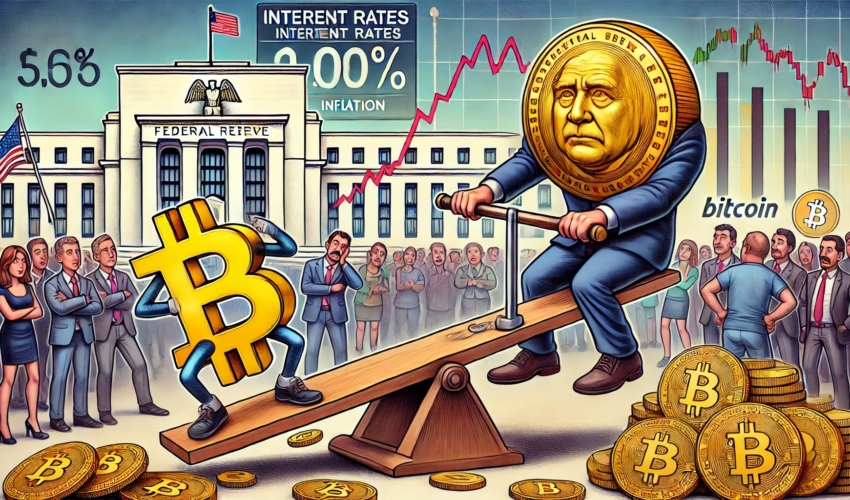The Federal Reserve’s Monetary Policy and Its Impact on Bitcoin
At the end of2024,theU.S.Federal Reserve(FRB)shifted its stance towards monetary easing,lowering interest rates for the first time in18months.During theDecember FOMC(Federal Open Market Committee)meeting,the central bankcut its benchmark interest rate by0.25%,setting the federal funds rate target range at4.25–4.50%.This was the third consecutive rate cut since September,and while it provided some relief to the markets,the Fed maintained a cautious stance,emphasizing thatinflation remains a concern.The central bank also revised its2025rate cut forecast,reducing the expectedtotal cuts from1.0%to0.5%(two cuts of0.25%each).This adjustment,seen as a**”hawkish rate cut,”signaled thatmonetary easing in2025would be limited**,keeping financial conditions tighter than initially expected.
The Federal Reserve’s cautious approach immediately impacted the Bitcoin market.Although the rate cut itself was already priced in,Fed Chair Jerome Powell’s comments and the economic forecast lowered investor expectations for future rate cuts.As a result,Bitcoin’s price,which was trading around$104,000before the announcement,dropped to approximately$101,000during Powell’s press conference.Within24hours,Bitcoin fell by around5%,temporarilybreaking below the critical$100,000level.This reaction underscores howthe Fed’s monetary policy stance directly influences the Bitcoin market,particularly through changes in liquidity expectations.
Inflation Data and Bitcoin Price Trends
Another key factor influencing the Bitcoin market isU.S.inflation data.In December2024,the U.S.Consumer Price Index(CPI)for November was reported at**+2.7%year-over-year**,confirming that inflation had moderated toward the Fed’s2%target.The decline in inflation providedoptimism that the Fed would continue easing monetary policy,leading toa surge in risk appetite among investors.Following theCPI report,Bitcoin’s pricespiked sharply from around$98,000to an all-time high of$108,000.This rally reflected growing confidence thatthe tightening cycle was endingand that financial conditions would soon loosen.
However,Bitcoin’s momentum quickly reversedafter hitting itsrecord high.The market shift was triggered bythe Fed’s December FOMC meeting,which signaled amore restrictive approach to monetary policy in2025.As a result,expectations for continued rate cuts werescaled back,leading toprofit-taking among investors.Over the following days,Bitcoin dropped3–4%,reflectingreduced optimism about monetary easing.Before the Fed’s decision,Bitcoin had already shown signs of volatility,with a6%drop to$99,000in the24hours following the announcement,affecting the broader crypto market as well.XRP fell by13%,Dogecoin dropped12%,and overallcrypto market capitalization declined sharply.This illustrates howinflation trends and subsequent Fed reactions significantly influence Bitcoin’s price volatility.
Market Outlook and Key Events to Watch
Looking ahead,the next FOMC meeting in mid-March2025will be themost critical event for the Bitcoin market.The Fed is expected toimplement1–2additional rate cutsthroughout the year,with March and June being themost likely timeframes.Financial institutions are forecasting thatafter a0.25%cut in December,the Fed will lower rates again in March and June before pausing to assess inflation trends.If the Fedannounces another rate cut in March,it couldboost risk assets like Bitcoin.However,if the Fedkeeps rates unchanged or signals a more hawkish stance,disappointment could triggeranother round of selling in the crypto market.
Investor sentiment will also remainhighly sensitive to U.S.economic indicators and monetary policy decisions.Following theDecember“hawkish”rate cut,investors have becomemore cautious,leading toposition adjustments and profit-taking.Open interest inBitcoin futures contracts has declined,indicating that traders arereducing leverage and taking a wait-and-see approach.Some analysts suggest thatthe market is now entering a”cooling-off phase”after failing tosustain gains above$105,000in January.Short-term projections suggest thatBitcoin could temporarily drop to the high$90,000rangeas investors reassess their outlook.
The future trajectory of the Bitcoin market will largely depend oninflation trends and the Fed’s monetary policy.Investors are closely monitoringmonthly CPI reports,as lower-than-expected inflation couldfuel expectations for additional rate cuts,pushing Bitcoin higher.Conversely,if inflation remainsstubbornly high,the Fed maymaintain higher interest rates for longer,dampening risk appetite and putting downward pressure on Bitcoin.The market remainshighly reactive to any shifts in the Fed’s stance,and Bitcoin traders will continueclosely watching upcoming economic data and central bank announcements.
Final Thoughts
TheBitcoin market remains heavily influenced by macroeconomic conditions,particularlyU.S.inflation data and Federal Reserve policy.Whilerate cuts and easing inflation initially fueled optimism,the Fed’scautious stance has tempered expectations for rapid monetary easing.As a result,Bitcoin’s price remains volatile,with major market movements triggered by inflation reports and Fed decisions.In the short term,March’s FOMC meeting and upcoming CPI releaseswill be thekey catalystsfor Bitcoin’s next price movement.Investors should stay prepared forcontinued market fluctuations driven by macroeconomic events.












